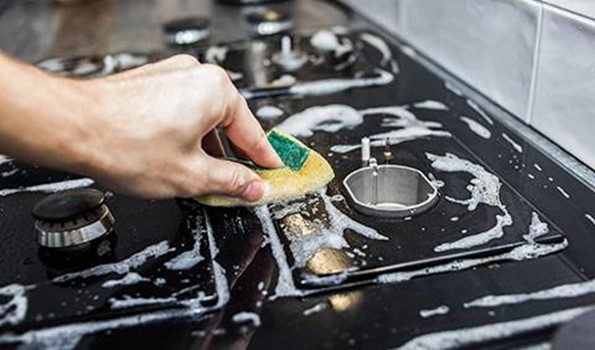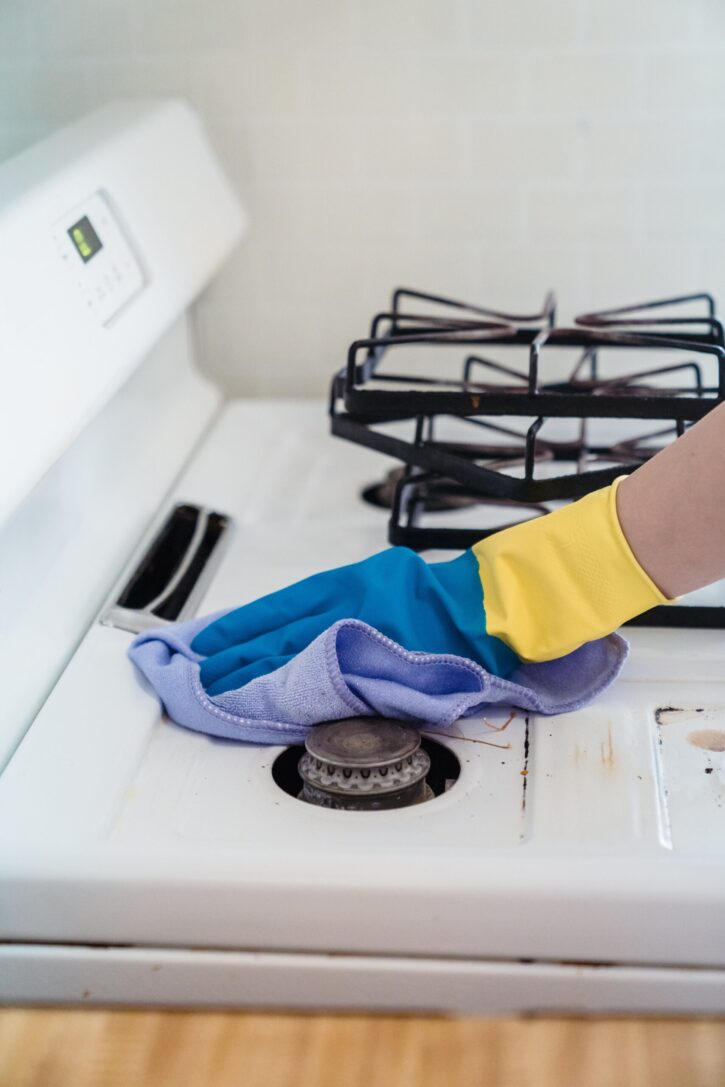
How to Remove Tough Stains and Grease from a Stove Top
Your stove likely experiences the most spills, splashes, and stains on any kitchen surface. Even worse, the burners’ high heat may bake messes on, making them hard to clean up. Spot-cleaning small spills at meals and setting aside time each week to do a more complete stove cleaning in Los Angeles can keep it looking spotless. It simply takes a fast spritz of cleaner and a swipe with a moist cloth to clean your kitchen regularly. By following this simple procedure, you can stop food and oils from solidifying on your stovetop. But, deep cleaning your stovetop once a week involves a bit more effort. We’ll teach you the most effective method to get rid of cooking odors, whether you have a glass cooktop, a gas stove, or electric coil burners.
First Things First
The inner workings of stoves, especially those with gas stovetop burner heads, are complicated and vary widely from model to model and brand to brand. To avoid damaging the burner and causing it to malfunction or become a hazard, you should be well-versed in how to clean the stove burners on your device. A useful source of information is your owner’s manual. Some schematics show you precisely how to clean your stovetop inside along with directions particular to your model. No sign of your manual? You might be able to get a digital copy online by searching for the model number, which is frequently found on a label inside the door, or by visiting the manufacturer’s website, which may offer deep cleaning instructions and instructional videos.
Cleaning a Glass Stove Top
Electric stoves with glass tops have gained popularity over time. They are nearly invisible on a kitchen counter since they are flat, sleek, and smooth. Additionally, they now offer better safety features. Modern electric stovetops feature induction cooking technology, which allows water to be boiled while keeping the cooking surface cold to the touch.
The simplicity of maintenance is a major selling point for glass stovetops. Kitchen elements that are simple to clean are advantageous in this tough space. Every meal requires little more than wiping a level surface with a moist towel. But after a few days of cooking, grease splatters and bubbling sauce can accumulate. If you need a little more deep cleaning power, spritz with little vinegar before wiping.
Cleaning Stains Off of a Glass Stove Top
Using a single-edged scraper to remove difficult stains from a glass stove top is one of the most effective deep cleaning methods. You may use the scraper to attack clinging buildup as well as difficult-to-clean edges and crevices.
Things Needed:
- One-edged scraper
- Cleaner (recommended for glass stove tops)
- Clean cloth
Step 1: Soak the stovetop
Give the troublesome spot several minutes to soak in a cleaner designed for glass stove tops.
Step 2: Scrape the stovetop
Next, using a low 30- to a 40-degree angle and slow, firm scraping motions, remove the dirt. To prevent accidentally cracking the glass, don’t push too firmly or hold the scraper at a sharp angle.
Step 3: Dry the stovetop
Utilize a clean towel to wipe the glass cooktop.
Deep Cleaning Guide for a Glass Cooktop
Try this cleaning technique which uses deep cleaning with vinegar and baking soda, two of our favorite natural cleaners, for a general all-over thorough scrub.
Thing Needed:
- Vinegar
- Baking soda
- Clean cloth
- Microfiber cloth
Step 1: Apply vinegar and baking soda to clean
Once the glass stove top has cooled, liberally sprinkle baking soda over it and spray it with vinegar.
Step 2: Warm-water soaking
With hot water, dampen a cloth, then squeeze out any remaining moisture. For ten to fifteen minutes, place the towel over the burner.
Step 3: Remove the remaining dirt
When deep cleaning the stove, take off the towel and use a microfiber cloth. To remove any stains, reapply a light vinegar spray and wipe the surface with a fresh, dry microfiber cloth. The residue must be removed by repeating these processes.
Step 4: Dry the stovetop
Utilize a clean towel to wipe the glass cooktop.
Cleaning Gas Stove Burners
 Photo by Liliana Drew
Photo by Liliana Drew
Look under the burner caps occasionally to see whether the burner heads require deep cleaning. Burner heads must be kept clean for proper gas flow. Make sure the stovetop is cold and that all the burners are off before beginning.
Things Needed:
- Toothbrush
- Wet cloth
- Microfiber cloth
Step 1: Clean up spills.
Grab the grate. Any spills on the burner head and slots should be cleaned up with a wet cloth.
Step 2: Get rid of crumbs.
In a house deep cleaning process, use a nonabrasive brush such as a toothbrush to get rid of any crumbs in the spaces between the burner slots. Use a wet towel to wipe.
Step 3: Change the grates.
Reinstall the grates on the stove after wiping them dry with a microfiber towel.
Cleaning an Electric Stovetop
Although they cook with electricity, electric coil stovetops resemble gas burners. The heat knobs on the electric-powered coil burners allow for adjustable, uniform heating. For households with small children or curious dogs, cooking without a flame may be the best option. Electric coil burners are susceptible to cooking residue buildup, much like the grates on a gas stovetop.
Step 1: Take the electric coil burners out.
You must first remove the electric coil burners before the deep cleaning process. Unplug the burner slowly once the stovetop has cooled.
Step 2: Clean the burners
Use a sponge dipped in warm, soapy water to clean the burners. Avoid getting the electrical connector wet when cleaning. After rinsing, let the area completely dry.
Step 3: Clean the stovetop
Use a moist cloth or sponge to thoroughly clean the rest of your electric stovetop while the burners are drying. For any very tough stains, use an all-purpose cleaner.
Step 4: Clean the drip plates
If the drip plates under the burners can be taken out, give them a deep cleaning with vinegar and baking soda.
Baking soda on the drip pans, hot vinegar gently poured into the drip pans, let to remain for 30 minutes, then scrubbed clean with a wet sponge and rinsed with water.
Step 5: Reattach the electric coil burners
If you removed the drip plates in step 4, replace them with a microfiber towel while you dry the clean stovetop before reinserting the coil burners.
Once your stovetop is spotless, look below to see whether your oven also needs to be cleaned.
How frequently should your stovetop be cleaned?
Once-a-week stove cleaning in Los Angeles is recommended, depending on how frequently you use it. If you use it frequently, it’s best to clean up spills, splatters, and filth right away. As a result, the quantity of surface buildup will be reduced, and house cleaning Los Angeles will be easier.








Thanks for the tips, I so need to clean my oven, got any great tips for that.
Thank you for sharing these great tips